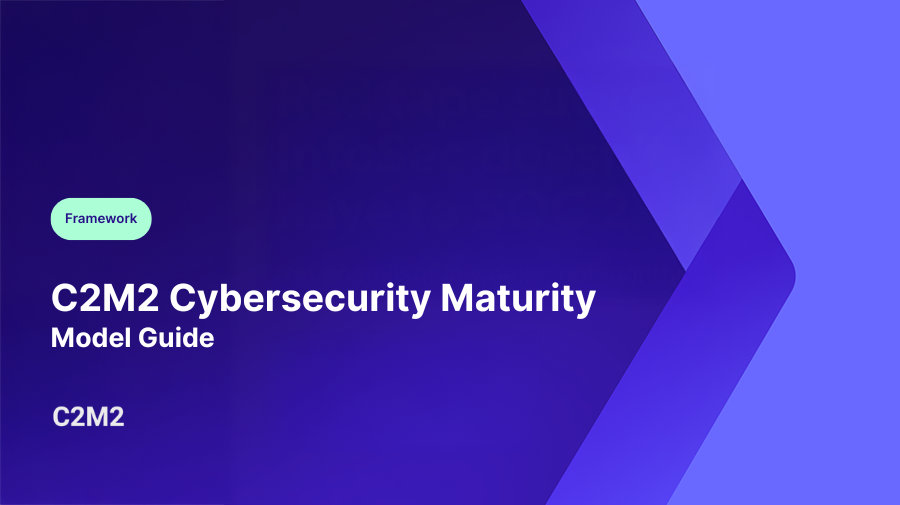Initial
Practices are ad hoc and reactive with limited consistency or documentation.

As cyber threats evolve, organizations are under growing pressure to prove that they not only have strong defenses, but also a structured approach to improving them.
That’s where the Cybersecurity Capability Maturity Model (C2M2) comes in. Originally developed by the U.S. Department of Energy, C2M2 helps organizations of all sizes evaluate and strengthen their cybersecurity posture in a scalable, repeatable way.
The Cybersecurity Capability Maturity Model (C2M2) is a framework that helps organizations assess, prioritize, and improve their cybersecurity practices. Unlike rigid standards that focus solely on compliance, C2M2 measures how well cybersecurity capabilities are implemented, managed, and improved across the enterprise.
C2M2 is widely used by organizations in critical infrastructure sectors such as energy, transportation, and finance, but is adaptable to any industry seeking a structured maturity model.
The framework is organized around ten domains, each describing a set of objectives that represent a key area of cybersecurity management.
C2M2 offers a common language for measuring cybersecurity maturity, helping organizations:
It’s not a certification, but a roadmap for measurable progress. Many organizations use C2M2 alongside frameworks like NIST CSF, ISO 27001, and CIS Controls to benchmark and align their cybersecurity programs.
C2M2 defines ten domains, each representing a critical component of cybersecurity capability. Together, they guide how an organization manages assets, risk, and resilience.
1. Risk management: defines how risks are identified, evaluated, and prioritized.
Organizations with higher maturity proactively analyze risks and integrate mitigation into business strategy.
2. Asset, change, and configuration management: ensures that hardware, software, and system changes are tracked and controlled to minimize vulnerabilities.
3. Identity and access management: focuses on controlling access to systems and data through defined roles, authentication, and monitoring.
4. Threat and vulnerability management: involves identifying, analyzing, and mitigating
emerging threats before they cause harm.
5. Situational awareness: covers real-time visibility into network and system activity to detect anomalies and security events.
6. Information sharing and communications: promotes collaboration across departments and with external partners to share threat intelligence and response updates.
7. Event and incident response: defines how security events are detected, analyzed, contained, and recovered from efficiently.
8. Supply chain and external dependencies: evaluates third-party risks, emphasizing vendor security practices and resilience of outsourced services.
9. Workforce management: assesses how training, roles, and responsibilities support cybersecurity awareness and readiness.
10. Cybersecurity program management: establishes governance structures, performance monitoring, and continuous improvement processes for cybersecurity.
C2M2 measures progress across four maturity levels, known as Maturity Indicator Levels (MILs):
Progressing from MIL0 to MIL3 indicates growing maturity, resilience, and repeatability across all ten domains.
Implementing the C2M2 framework involves several key phases:
Define scope and objectives: determine which business units, processes, or systems the assessment will cover.
Conduct a baseline assessment: evaluate current cybersecurity practices across all ten domains to establish a maturity baseline.
Identify gaps and prioritize risks: compare results against target maturity levels and identify where capabilities fall short.
Develop an improvement roadmap: outline actionable projects to close gaps, with assigned owners, milestones, and budgets.
Integrate with existing frameworks: map C2M2 objectives to frameworks like NIST CSF or ISO 27001 for broader governance alignment.
Monitor progress continuously: repeat assessments periodically and adjust the roadmap as new threats or technologies emerge.
The C2M2 framework gives organizations a clear structure for understanding where they are in their cybersecurity journey and how to mature over time. It emphasizes risk awareness, consistent improvement, and measurable progress, helping teams build stronger, more resilient security programs.
With platforms like Complyance, organizations can track maturity across domains, automate evidence collection, and visualize improvements year over year; moving from compliance to true cybersecurity capability.
Is C2M2 mandatory for compliance? No. C2M2 is voluntary but is widely recognized by regulators and industry bodies as a best-practice maturity framework.
Can C2M2 be certified? No. Unlike ISO standards, C2M2 is not certifiable. It’s used for internal evaluation and improvement tracking.
How does C2M2 compare to NIST CSF? C2M2 provides a maturity-based approach to measuring implementation depth, while NIST CSF focuses on cybersecurity functions and outcomes.
How often should organizations reassess? Best practice suggests conducting a C2M2 self-assessment at least annually or after major business or technology changes.
